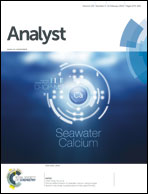A cubic luminescent graphene oxide functionalized Zn-based metal-organic framework composite for fast and highly selective detection of Cu2+ ions in aqueous solution†
Abstract
In this work, a graphene oxide functionalized Zn-based metal–organic framework (ZnMOF) was synthesised under a one-pot condition. This ZnMGO composite had high luminescence and good water dispersibility. The luminescence of the aqueous ZnMGO composite was efficiently and selectively quenched by Cu2+ ions through interactions between Cu2+ and the ligand. The detection limit was measured at concentrations as low as 1.00 μM. This robust ZnMGO composite demonstrated a fast response and high sensitivity (Ksv = 3.07 × 104 M−1) for Cu2+ ions in aqueous solution. Moreover, the possible luminescence mechanism in terms of energy migration or electron transfer was further explored, and the quenching mechanism was discovered to be based on the collapse of the crystal structure with the help of various characterizations. Remarkably, it is the first time that this excellent ability possessed by the ZnMGO composite has been used to rapidly detect Cu2+ ions in aqueous solution. The work does not only contribute to extend the potential application of ZnMGO composites, but it also aims to make a contribution within the biological sciences.


 Please wait while we load your content...
Please wait while we load your content...